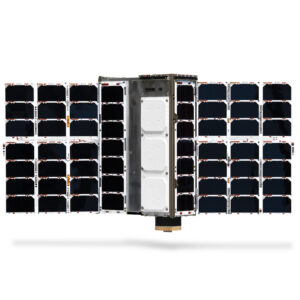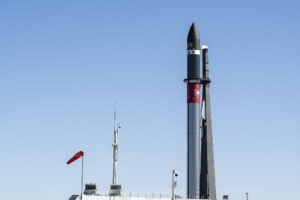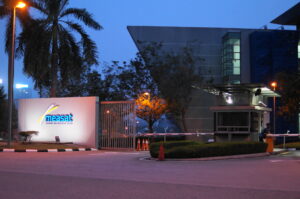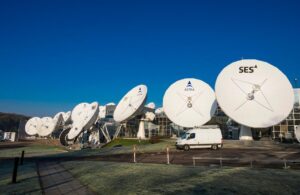NESDIS awards enterprise cloud contract to SAIC and Carahsoft
Thursday, 04 August 2022 19:00
The National Oceanic and Atmospheric Administration announced the award Aug. 3 of a $15 million contract for cloud services to SAIC and Carahsoft.
The post NESDIS awards enterprise cloud contract to SAIC and Carahsoft appeared first on SpaceNews.
Spire to host second optical payload for South Korea’s Hancom
Thursday, 04 August 2022 18:25
Spire Global said Aug. 4 it will host a second Earth-imaging payload for Hancom InSpace, which became the first private South Korean company to operate a commercial satellite mission earlier this year.
NRO’s spy satellite fleet to become more diverse
Thursday, 04 August 2022 16:50
NRO Director Scolese said the agency will continue to build large, bespoke satellites but also will increasingly rely on lower cost commercial smallsats
The post NRO’s spy satellite fleet to become more diverse appeared first on SpaceNews.
Blue Origin sends first Egyptian and Portugese nationals to space
Thursday, 04 August 2022 16:08
Jeff Bezos' Blue Origin on Thursday launched six people to space, including the first from Egypt and Portugal, on the company's sixth crewed flight.
Mission "N-22" saw the New Shepard suborbital rocket blast off around 8:58 am local time (1358 GMT) from Blue's base in the west Texas desert.
The autonomous, re-usable vehicle sent its crew capsule soaring above the Karman line, the internationally recognized space boundary, 62 miles (100 kilometers) above sea level.
"I'm floating!" a crew mate could be heard saying on a livestream, as the capsule coasted to its highest point and the passengers experienced a few minutes of weightlessness.
Both the rocket and capsule separately returned to the base—the latter using giant parachutes—completing the mission around 11 minutes after lift-off.
Insurance claim for failed Measat-3 satellite in dispute
Thursday, 04 August 2022 15:50
An insurance claim for a Malaysian satellite that ran out of fuel prematurely remains unsettled more than a year after the incident.
The post Insurance claim for failed Measat-3 satellite in dispute appeared first on SpaceNews.
Beyond Artemis I—NASA plots cheaper rocket rollout while Congress calls for more flights
Thursday, 04 August 2022 15:41
NASA has yet to get its next-generation moon rocket off the ground, but this week announced a shift in how it plans to pay for future launches while also falling under a new directive from Congress to increase the number of flights each year.
Artemis I, a combination of the Space Launch System rocket and Orion capsule, is set to roll out from Kennedy Space Center's Vehicle Assembly Building on Aug. 18 to Launch Pad 39-B ahead of a potential liftoff as early as Aug. 29. The uncrewed test flight will send Orion on a mission that could last up to 42 days traveling more than 1 million miles including several orbits around the moon.
The primary goal is to sign off on Orion's ability to support crew for future missions, including testing a heat shield that can endure the stresses of an intense re-entry.
"Orion will come home faster and hotter than any spacecraft has before," said NASA Administrator Bill Nelson during a press conference Wednesday. "It's going to hit the Earth's atmosphere at 32 times the speed of sound.
Consolidation wave pushes rivals SES and Intelsat into merger talks
Thursday, 04 August 2022 14:07
SES and Intelsat are in active merger talks as a wave of consolidation sweeps over the satellite industry, the Financial Times reported Aug. 4.
The post Consolidation wave pushes rivals SES and Intelsat into merger talks appeared first on SpaceNews.
Blue Origin launches sixth New Shepard crewed suborbital flight
Thursday, 04 August 2022 13:24
Blue Origin launched its New Shepard suborbital vehicle on its sixth crewed flight in a little more than a year Aug. 4, carrying six people that included the first individuals from Egypt and Portugal to go to space.
Geospatial analysis provider Descartes Labs sold to private equity firm
Thursday, 04 August 2022 11:51
Private equity firm Antarctica Capital has acquired geospatial analytics provider Descartes Labs to support its growing space-based data portfolio.
The post Geospatial analysis provider Descartes Labs sold to private equity firm appeared first on SpaceNews.
ULA launches missile warning satellite for US Space Force
Thursday, 04 August 2022 11:11 United Launch Alliance launched a missile warning satellite for the U.S. Space Force on Thursday morning. ULA launched SBIRS GEO-6, into orbit on its Atlas V rocket on time at 6:29am. The SBIRS GEO-6 is an enhanced satellite built by Lockheed Martin that uses the LM 2100 Combat Bus to provide "even greater resiliency and cyber-hardening against growing threats"
United Launch Alliance launched a missile warning satellite for the U.S. Space Force on Thursday morning. ULA launched SBIRS GEO-6, into orbit on its Atlas V rocket on time at 6:29am. The SBIRS GEO-6 is an enhanced satellite built by Lockheed Martin that uses the LM 2100 Combat Bus to provide "even greater resiliency and cyber-hardening against growing threats" As reflective satellites fill the skies, UA students helping astronomers adapt
Thursday, 04 August 2022 11:11 As satellites crawl across the sky, they reflect light from the sun back down to Earth, especially during the first few hours after sunset and the first few hours before sunrise. As more companies launch networks of satellites into low-Earth orbit, a clear view of the night sky is becoming rarer. Astronomers, in particular, are trying to find ways to adapt.
With that in mind, a team of Uni
As satellites crawl across the sky, they reflect light from the sun back down to Earth, especially during the first few hours after sunset and the first few hours before sunrise. As more companies launch networks of satellites into low-Earth orbit, a clear view of the night sky is becoming rarer. Astronomers, in particular, are trying to find ways to adapt.
With that in mind, a team of Uni SpaceX debris discovered in Australian sheep paddock
Thursday, 04 August 2022 11:11 A charred chunk of space junk found jutting from a paddock by an Australian sheep farmer was confirmed to be part of one of Elon Musk's SpaceX missions by authorities Thursday.
The ethereal-looking debris, believed to have plummeted to Earth on July 9, was found last week in Dalgety - a remote area near Australia's Snowy Mountains, about five hours' drive southwest of Sydney.
"It was ki
A charred chunk of space junk found jutting from a paddock by an Australian sheep farmer was confirmed to be part of one of Elon Musk's SpaceX missions by authorities Thursday.
The ethereal-looking debris, believed to have plummeted to Earth on July 9, was found last week in Dalgety - a remote area near Australia's Snowy Mountains, about five hours' drive southwest of Sydney.
"It was ki Slingshot Aerospace acquires Numerica's space division and UK-Based Seradata
Thursday, 04 August 2022 11:11 Slingshot Aerospace, Inc., a company building space simulation and analytics products to accelerate space sustainability, has announced that the company has acquired Numerica's Space Domain Awareness (SDA) division and UK-based Seradata.
Numerica's SDA division includes the world's first and only commercial low Earth orbit (LEO) to geosynchronous orbit (GEO) daytime and nighttime optical s
Slingshot Aerospace, Inc., a company building space simulation and analytics products to accelerate space sustainability, has announced that the company has acquired Numerica's Space Domain Awareness (SDA) division and UK-based Seradata.
Numerica's SDA division includes the world's first and only commercial low Earth orbit (LEO) to geosynchronous orbit (GEO) daytime and nighttime optical s ASTRA announces major new equity facility
Thursday, 04 August 2022 11:11 Astra Space, Inc. (NASDAQ: ASTR) has entered into a common stock purchase agreement with B. Riley Principal Capital II, LLC ("B. Riley Principal Capital II"). The agreement governs a Committed Equity Facility that provides Astra the right, in its discretion and without obligation, to sell and issue up to $100 million of its Class A common stock over the course of 24 months to B. Riley Principal
Astra Space, Inc. (NASDAQ: ASTR) has entered into a common stock purchase agreement with B. Riley Principal Capital II, LLC ("B. Riley Principal Capital II"). The agreement governs a Committed Equity Facility that provides Astra the right, in its discretion and without obligation, to sell and issue up to $100 million of its Class A common stock over the course of 24 months to B. Riley Principal Tonga eruption blasted unprecedented amount of water into stratosphere
Thursday, 04 August 2022 11:11 When the Hunga Tonga-Hunga Ha'apai volcano erupted on Jan. 15, it sent a tsunami racing around the world and set off a sonic boom that circled the globe twice. The underwater eruption in the South Pacific Ocean also blasted an enormous plume of water vapor into Earth's stratosphere - enough to fill more than 58,000 Olympic-size swimming pools. The sheer amount of water vapor could be enough to t
When the Hunga Tonga-Hunga Ha'apai volcano erupted on Jan. 15, it sent a tsunami racing around the world and set off a sonic boom that circled the globe twice. The underwater eruption in the South Pacific Ocean also blasted an enormous plume of water vapor into Earth's stratosphere - enough to fill more than 58,000 Olympic-size swimming pools. The sheer amount of water vapor could be enough to t 
